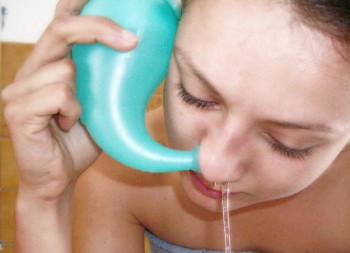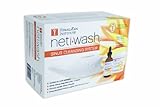- in Health & Beauty , Remedies by Alexis Rodrigo
3 Options for Nasal Irrigation

I used to get allergic rhinitis several times a year. And it always involved appointments with a specialist, ear and sinus infections, and, finally, having to take antibiotics. Several times a year.
Until I discovered nasal irrigation.
Nasal irrigation is, quite simply, the cleansing of our nasal passages with warm salt water. It flushes away irritants and excess mucus, soothes the mucus membranes, and reduces inflammation.
Since I learned how to do nasal irrigation, I’ve been able to shorten the duration of colds, head off sinusitis infections, and avoid antibiotics altogether.
There are several ways to do nasal irrigation. Here are three I’ve tried. They’re all effective but you may choose to use different ones, depending on the situation:
1. Neti Pot

This is probably the original nasal irrigation device ever invented. The word “neti” is a Sanskrit word for “nasal irrigation.” It comes from the ancient practice of Ayurveda, which is the traditional alternative medicine of India.
Pros
- inexpensive
- simple to use, doesn’t require electricity or accessories
Cons
- requires warming up water
- requires washing after each use and sanitizing occasionally
- takes coordination and patience to use, because you need to lean over the sink with your head at a certain angle (check out the picture of a lady using a neti pot above)
- hard to use on kids
2. Electric Nasal/Sinus Irrigator

I received a free sample of the Sanvic Nasal/Sinus Irrigator to mention on this blog. It’s an electric device for nasal irrigation, sort of like a Water Pik for the nose 😉
UPDATE: The 8-year-old munchkin boy has a mild viral infection, and our family doctor recommended that I use a neti pot with him. There’s no way he would let me use a traditional neti pot, so I used our Sanvic Nasal/Sinus Irrigator. It “tickled” him at first, but worked extremely well to ease his congestion. This is definitely a winner for kids!
Pros
- very easy to use, even on young children
- can be shared by family members, because you can order one tip for each individual. Child-friendly tips are also available
- adjustable flow strength, so beginners can start with the lowest setting then move up as they get more comfortable
- nasal irrigation is completed a lot faster than with a neti pot
Cons
- expensive
- requires counter space
- requires warming up water
- requires washing after each use and sanitizing occasionally
3. Saline Nasal Spray

This is what my family doctor recommended I use when I whined about not being able to irrigate my nose several times a day. She was right, a pre-packaged saline spray is fast and convenient.
Pros
- ready to use any time: No warming up water, mixing solutions, cleaning, or sanitizing required
- travel-friendly
- convenient to use even when you’re away from home
- comes in child-friendly variants
Cons
- can’t be shared by individuals
- if using during an active infection, you need to discard the bottle when you get well, so you don’t risk re-infecting yourself
- creates waste
- not as soothing as the warm saline water in either the neti pot or electric nasal irrigator
The Bottom Line
So which nasal irrigation device would I recommend? It depends. It depends on who’s using it and under what circumstances.
For children, I would recommend the saline nasal spray for ease of use. And if you can afford it, I would recommend the electric nasal irrigator, too. It delivers a warm, soothing nasal wash without the learning curve and even discomfort of using a neti pot.
For adults, again, it depends. For use in the office and while travelling, it couldn’t get any easier than the saline nasal spray (take note of airline regulations regarding fluids, though, if you’re flying). If you can afford it, the electric nasal irrigator’s good, but unnecessary. You could do just as well with the much less expensive neti pot — unless you find the neti pot too difficult to master.
How about you? Do you do nasal irrigation? If so, what do you use?
If you liked this post, submit your email address below to get new posts by email:
